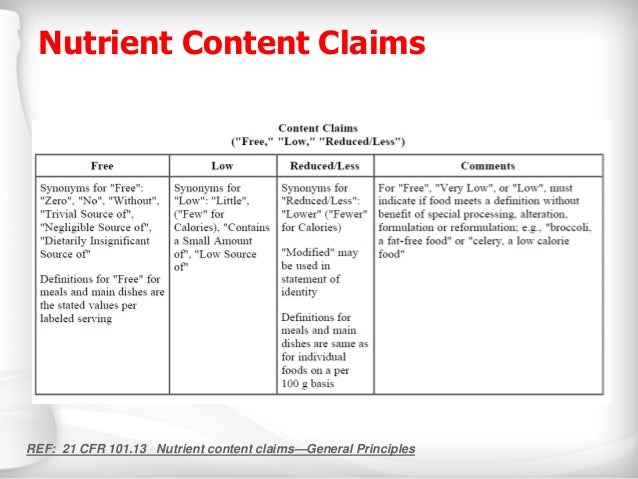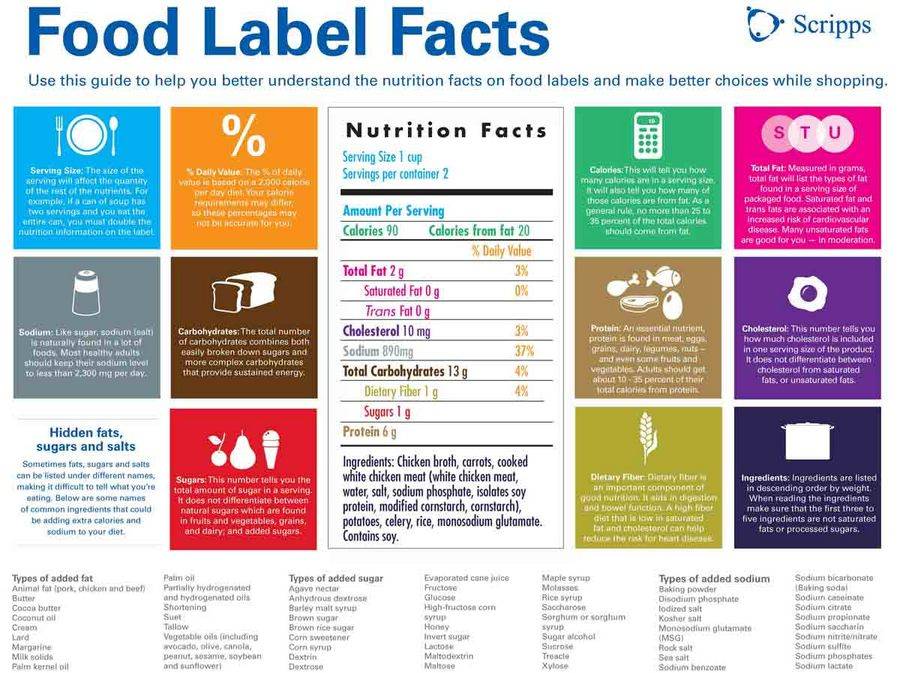38 nutrient content claims on food labels
Label Claims for Conventional Foods and Dietary Supplements Nutrient Content Claims The Nutrition Labeling and Education Act of 1990 (NLEA) permits the use of label claims that characterize the level of a nutrient in a food (i.e., nutrient content claims)... eCFR :: 21 CFR 101.10 -- Nutrition labeling of restaurant foods whose ... § 101.10 Nutrition labeling of restaurant foods whose labels or labeling bear nutrient content claims or health claims. Nutrition labeling in accordance with § 101.9 shall be provided upon request for any restaurant food or meal for which a nutrient content claim (as defined in § 101.13 or in subpart D of this part) or a health claim (as defined in § 101.14 and permitted by a regulation in ...
Factual Food Labels: Health Claims This type of claim describes the nutritional content and nutrient levels of the food product in comparison to the accepted standard of the product. The terms that are used in this type of label is "free," "reduced," "high," and "low." These type of claims are only applicable to nutrients that have a % daily value established such as saturated ...

Nutrient content claims on food labels
Protein Label - LabelCalc To have a nutrient content claim of a food being a "Good Source of Protein" the food must contain 10-19% of the DV per RACC, or 5 to 9.5g of protein per RACC. If you would like to have your food product touted as having "more protein" than a referenced food, your product must have 10% more of the DV per RACC than the referenced food ... Food Labeling & Nutrition | FDA Food labeling is required for most prepared foods, such as breads, cereals, canned and frozen foods, snacks, desserts, drinks, etc. Nutrition labeling for raw produce (fruits and vegetables) and... The Nutrition Facts panel on a food label lists the following ... The nutrition facts label includes: serving size; calories % daily values ; information about fat, cholesterol, fiber, added sugars, protein, and other nutrients; Other information on the food label: content claims, such as "light" or "low-fat," that must meet strict government definitions so that they are accurate and consistent from one food ...
Nutrient content claims on food labels. Status of Nutrition Labeling, Health Claims, and Nutrient Content ... The Food and Drug Administration (FDA) conducts studies of food labels as part of its ongoing monitoring of the nutritional status of the US population. In 1994 FDA nutrition labeling rules were implemented and in 1997 the Food Label and Package Survey characterized various aspects of the labeling o … History of Nutrition Labeling - Front-of-Package Nutrition Rating ... Up to the late 1960s, there was little information on food labels to identify the nutrient content of the food. From 1941 to 1966, when information on the calorie or sodium content was included on some food labels, those foods were considered by the Food and Drug Administration (FDA) to be for "special dietary uses," that is, intended to meet particular dietary needs caused by physical ... Label Claims for Food & Dietary Supplements | FDA Among the claims that can be used on food and dietary supplement labels are three categories of claims that are defined by statute and/or FDA regulations: health claims, nutrient content claims,... Nutrition content claims and health claims - Food Standards Nutrition content claims are about the content of certain nutrients or substances in a food, such as 'low in fat ' or 'good source of calcium'. These claims need to meet certain criteria. For example, food with a 'good source of calcium' claim needs to contain at least the amount of calcium specified in the Standard. Health claims
Nutrient Claims on Food Labels - Truly Good Foods Nutrient Claims on Food Labels July 19, 2018 Nutrient claims describe the content of a food, including the amount of nutrients, calories, cholesterol or fiber, but not in exact amounts. Usually on the front of the food label, the nutrient claim provides a quick comparison between similar products. Making a nutrient content claim on food labels - Food labels - Canadian ... Non-prepackaged products and prepackaged products exempted from showing a Nutrition Facts table are permitted to make nutrient content claims or other permitted nutrition-related statements or representations on either the label for the food and/or in an advertisement. However, if a claim is made by or for the manufacturer for a prepackaged ... Assessing nutrition and other claims on food labels: a repeated cross ... Background: In 2010, nutrition claims were investigated in Canadian foods; however, many nutrition and other claims have been introduced since then. This study aimed to determine: i) the proportion of foods carrying claims in 2013, ii) the types and prevalence of nutrition claims (nutrient content claims, health claims, general health claims) and other claims displayed on labels in 2013, iii ... Factual Food Labels: Health Claims - Master of Science in Nutritional ... This type of claim describes the nutritional content and nutrient levels of the food product in comparison to the accepted standard of the product. The terms that are used in this type of label is "free," "reduced," "high," and "low." These type of claims are only applicable to nutrients that have a % daily value established ...
How to Understand and Use the Nutrition Facts Label | FDA Dietary fiber, vitamin D, calcium, iron ad potassium are nutrients on the label that Americans generally do not get the recommended amount of. They are identified as nutrients to get more of.... Nutrient content claims - Canadian Food Inspection Agency Specific nutrient content claim requirements How to use the claims tables Energy and calorie claims Protein claims Fat claims Saturated fatty acid claims Trans fatty acid claims Omega-3 and omega-6 polyunsaturated fatty acid claims Cholesterol claims Sodium (salt) claims Potassium claims Carbohydrate and sugars claims Dietary fibre claims Understanding Food Labels | The Nutrition Source | Harvard T.H. Chan ... Under the Food Allergen Labeling and Consumer Protection Act of 2004, eight major food allergens—milk, fish, tree nuts, peanuts, shellfish, wheat, eggs, and soybeans—are required to be listed in a "contains" statement near the Ingredients list if present in a food. An example would be "contains wheat, milk, and soy." How to Read Labels on Food Packages: Facts, Photos, History, and More! "No salt," "low sugar," or "high fiber" are common content claims seen on packaging. Many nutritional claims are often inaccurate. Manufacturers often obfuscate some ingredients and therefore mislead consumers. 3. Serving Size This is usually the first item on the food label. It contains information about one serving size or its equivalent.
Nutrient content claims: what they mean - Canada.ca Table of nutrient-content claims and what they mean. The food provides an amount of a nutrient that is so small it likely won't have any effect on your body. The food is processed/modified so that it contains at least 25% less of the nutrient when compared with a similar product. Contains no added fats or oils or added butter or ghee, or ...
Nutrient Claims on Food Labels | Home & Garden Information Center Sodium content cannot exceed 360 mg per serving for individual foods and 480 mg per serving for meal-type products. If a food is labeled "healthy" or makes a health claim, it cannot contain any nutrient that increases the risk for disease. It must contain no more than 20% of the DV per serving of total fat, saturated fat, cholesterol, or sodium.
Food Packaging Claims | American Heart Association "Nutrient content claims" are used for two purposes: To describe the level of a nutrient in the product using terms such as free, high, and low or To compare the level of a nutrient in a food to another food using terms such as more, reduced, and lite.
Regulating health claims on food labels using nutrient ... - PubMed Nutrition composition and ingredients were collected from the packaging, enabling nutrient profiling. The proportion of products in each category carrying claims and the proportion of these that did not meet the nutrient profiling criteria were calculated. Results: Of those carrying health claims, 31 % did not meet the nutrient profiling criteria.
Nutrient Content Claims | FDA Nutrient Content Claims. See Claims That Can Be Made for Conventional Foods and Dietary Supplements for definitions of claims. Final Rule: Food Labeling: Nutrient Content Claims; Alpha-Linolenic ...
Nutrient Content Claims on a Food Label - LabelCalc The food product nutrition content must meet the strict guidelines and parameters set forth by the FDA in order to accurately make these nutrient content claims on a food label. For a more in-depth look at nutrient content claims, download this PDF. A Quick Reference Summary of Parameters
Food Labeling: Nutrient Content Claims; Alpha-Linolenic Acid ... the notification must contain specific information including: (1) the exact wording of the prospective nutrient content claim, (2) a concise description of the basis upon which the notifier relied for determining that the requirements for an authoritative statement in section 403 (r) (2) (g) (i) of the fd&c act have been satisfied, (3) a copy of …
Nutrient Content Claim vs Health Claim - LabelCalc Nutrient content claims, which are commonly used on food labels, either refer to the amount of a nutrient in a product or compare the levels of a nutrient in that food to a similar reference food. When referring to the amount of a nutrient in a product, words such as "low," "free," and "high" are often used.
Nutrient Content Claim "Light" - LabelCalc Basic Guidelines for Using the Nutrient Content Claim "Light". In order to use the term "light" on your label, your product has to comply with a few strict FDA guidelines. First, you must compare your product to a reference food that falls into the same category as yours. If your product is a "light" frozen yogurt, for instance, you ...
Understanding Food Labels and Health Claims - Nutrition Essentials This label is called a Nutrition Facts panel, which gives information on the number of servings per container, the number of calories per serving, and certain nutrients. Specifically, it lists the macronutrients and four of the most important micronutrients people need to pay special attention to, such as Vitamin D, Calcium, Iron, and potassium.
The Nutrition Facts panel on a food label lists the following ... The nutrition facts label includes: serving size; calories % daily values ; information about fat, cholesterol, fiber, added sugars, protein, and other nutrients; Other information on the food label: content claims, such as "light" or "low-fat," that must meet strict government definitions so that they are accurate and consistent from one food ...
Food Labeling & Nutrition | FDA Food labeling is required for most prepared foods, such as breads, cereals, canned and frozen foods, snacks, desserts, drinks, etc. Nutrition labeling for raw produce (fruits and vegetables) and...
Protein Label - LabelCalc To have a nutrient content claim of a food being a "Good Source of Protein" the food must contain 10-19% of the DV per RACC, or 5 to 9.5g of protein per RACC. If you would like to have your food product touted as having "more protein" than a referenced food, your product must have 10% more of the DV per RACC than the referenced food ...









Post a Comment for "38 nutrient content claims on food labels"